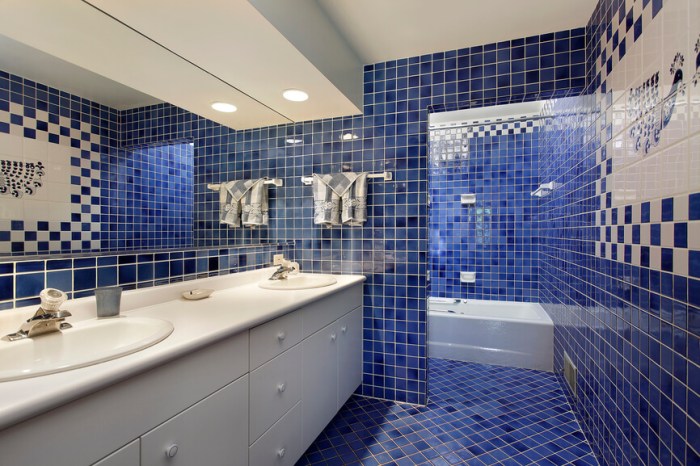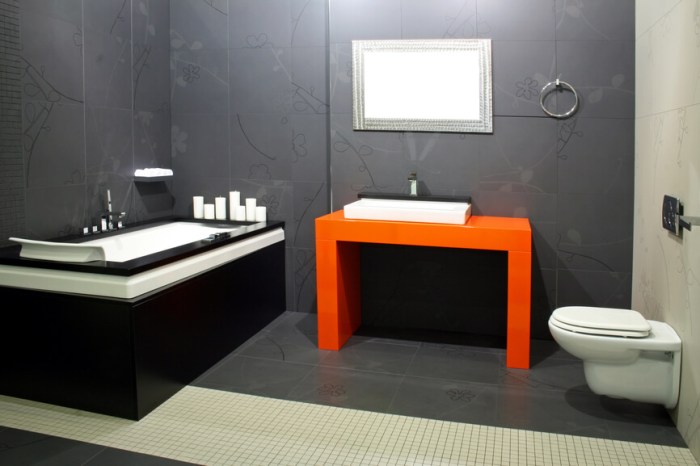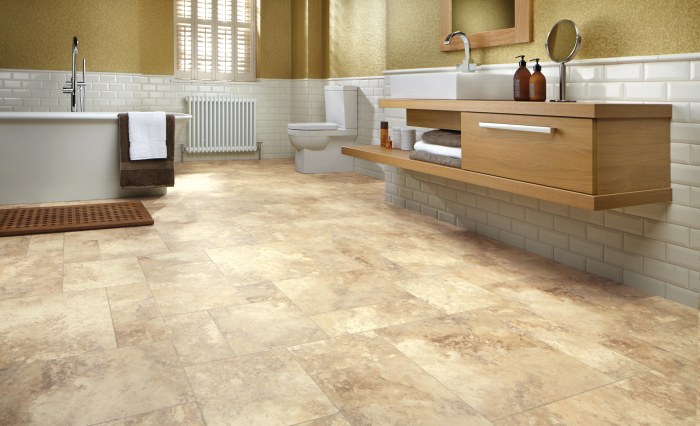Stepping into a bathroom with dark-colored floors is like entering a realm of understated elegance and dramatic flair. Dark floors in the bathroom create a captivating ambiance that sets the tone for a luxurious and sophisticated space. From deep charcoal to midnight blue, these floors add a touch of mystery and allure to any bathroom design.
In this comprehensive guide, we will delve into the world of dark-colored bathroom floors, exploring their dramatic impact, exploring various types of flooring materials, discussing lighting considerations, and providing tips on how to incorporate them seamlessly into different bathroom styles.
We will also cover essential maintenance and cleaning techniques to keep your dark-colored bathroom floors looking their best for years to come.
Types of Dark Colored Bathroom Flooring
Dark-colored bathroom flooring offers a dramatic and sophisticated look that can instantly transform the ambiance of any bathroom. With a wide range of materials available, choosing the right flooring for your bathroom can be a daunting task. In this section, we will explore the different types of dark-colored bathroom flooring materials, comparing their pros and cons, and identifying the most suitable options for various bathroom layouts and usage patterns.
Tile
Tile is a popular choice for bathroom flooring due to its durability, water resistance, and ease of maintenance. Dark-colored tiles, such as black, navy, or charcoal, can create a bold and striking statement. Porcelain and ceramic tiles are particularly well-suited for bathroom applications as they are highly water-resistant and non-porous.
However, tiles can be cold and hard underfoot, and they require professional installation.
Stone
Natural stone, such as marble, granite, or slate, offers a luxurious and timeless look for bathroom flooring. Dark-colored stone tiles, such as black marble or charcoal slate, can create a dramatic and sophisticated atmosphere. Stone flooring is highly durable and water-resistant, but it requires regular sealing to maintain its appearance.
Stone flooring can also be expensive and may require professional installation.
Vinyl
Vinyl flooring is a budget-friendly and versatile option for bathroom flooring. Dark-colored vinyl planks or tiles can mimic the look of wood or stone at a fraction of the cost. Vinyl flooring is waterproof, making it an excellent choice for bathrooms prone to moisture.
However, vinyl flooring can be susceptible to scratches and dents, and it may not be as durable as tile or stone.
Lighting Considerations for Dark Colored Bathroom Floors
Proper lighting is essential for dark-colored bathroom floors to prevent a gloomy atmosphere. Natural light is the most flattering, as it showcases the floor’s richness without overpowering it. If natural light is limited, consider installing large windows or skylights.Artificial lighting should be carefully chosen to complement the dark floors.
Warm, incandescent bulbs create a cozy and inviting ambiance, while cool, fluorescent bulbs provide a brighter and more modern look. Dimmers allow you to adjust the lighting intensity to create different moods and atmospheres.
Wall and Decor Combinations for Dark Colored Bathroom Floors
When pairing dark-colored bathroom floors with walls and decor, consider the following guidelines:
Wall Colors:
- Light colors like white, beige, or gray create a bright and airy contrast.
- Mid-tones such as navy, green, or brown add depth and sophistication.
- Dark colors like black or charcoal can create a dramatic and intimate atmosphere.
Decor Styles:
- Modern: Sleek lines, geometric patterns, and metallic accents.
- Traditional: Classic patterns, ornate fixtures, and natural materials.
- Bohemian: Eclectic patterns, bright colors, and global influences.
- Scandinavian: Clean lines, natural textures, and a minimalist approach.
Patterns, Textures, and Accessories
Incorporate patterns and textures to add visual interest:
- Patterns: Geometric tiles, striped wallpaper, or floral curtains.
- Textures: Natural stone, embossed tiles, or plush rugs.
- Accessories: Metallic fixtures, colorful towels, or unique artwork.
Maintenance and Cleaning Tips for Dark Colored Bathroom Floors
Dark-colored bathroom floors, while aesthetically appealing, require specific care and maintenance to preserve their beauty and longevity. Proper cleaning techniques and regular maintenance are crucial to prevent dirt, stains, and damage.
Cleaning Techniques
To remove dirt and grime from dark-colored bathroom floors, use a pH-neutral cleaner diluted with warm water. Avoid harsh chemicals or abrasive cleaners, as they can damage the floor’s surface. Use a soft cloth or sponge for cleaning, and rinse thoroughly with clean water.
Stain Removal
For stains, identify the type of stain and use an appropriate cleaning solution. For organic stains (e.g., food, drinks), use a solution of baking soda and water. For inorganic stains (e.g., rust, mineral deposits), use a vinegar solution.
Apply the solution to the stain, let it sit for a few minutes, and then wipe away with a damp cloth.
Water Spot Removal
Water spots can occur on dark-colored bathroom floors due to hard water. To remove them, apply a mixture of equal parts white vinegar and water to the spot. Let it sit for a few minutes, and then wipe away with a damp cloth.
Scratch Prevention
To prevent scratches on dark-colored bathroom floors, use felt pads under furniture and appliances. Avoid wearing shoes with sharp heels or objects that could scratch the floor. Use a doormat at the entrance to prevent dirt and debris from being tracked in.
Outcome Summary
Incorporating dark-colored bathroom floors into your bathroom design can transform it into a space that exudes both drama and sophistication. By carefully considering the type of flooring material, lighting, and complementary wall colors and decor, you can create a bathroom that is both visually stunning and highly functional.
Embrace the allure of dark-colored bathroom floors and let them add a touch of magic to your daily routine.



